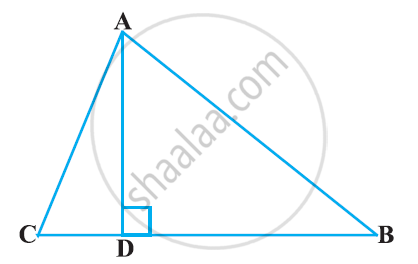Advertisements
Advertisements
Question
Prove that (1 + cot A - cosec A ) (1 + tan A + sec A) = 2
Solution
We have to prove (1 + cot A - cosec A ) (1 + tan A + sec A) = 2
We know that, `sin^2 "A" + cos^2 "A" = 1.`
So,
`(1 + cot"A" - "cosec""A")(1 + tan "A"+ sec "A") = (1 + (cos"A")/(sin"A") - (1)/(sin"A"))(1+(sin"A")/(cos "A")+(1)/(cos"A"))`
= `((sin"A" + cos "A"-1)/(sin"A"))((cos"A" + sin"A"+1)/(cos"A"))`
= `((sin "A" + cos"A" - 1)(sin "A"+ cos"A" + 1))/(sin"A" cos"A")`
= `{{(sin "A" + cos "A")-1} {(sin"A" + cos"A")+1}}/(sin"A" cos"A")`
= `((sin "A" + cos "A")^2-1)/(sin"A" cos"A")`
= `(sin^2 "A" + 2sin "A" cos"A"+ cos^2 "A"-1)/(sin"A" cos "A")`
= `((sin^2 "A" + cos^2 "A") + 2sin "A" cos "A" - 1)/(sin "A" cos"A")`
= `(1 + 2sin "A" cos "A" - 1)/(sin "A" cos "A")`
= `(2sin "A" cos "A")/(sin "A" cos "A")`
=2
Hence proved.
RELATED QUESTIONS
The perpendicular from A on side BC of a Δ ABC intersects BC at D such that DB = 3CD . Prove that 2AB2 = 2AC2 + BC2.

In ∆PQR, point S is the midpoint of side QR. If PQ = 11, PR = 17, PS = 13, find QR.
Some question and their alternative answer are given. Select the correct alternative.
If a, b, and c are sides of a triangle and a2 + b2 = c2, name the type of triangle.
In the right-angled ∆LMN, ∠M = 90°. If l(LM) = 12 cm and l(LN) = 20 cm, find the length of seg MN.
Find the length of the hypotenuse of a triangle whose other two sides are 24cm and 7cm.
In a triangle ABC, AC > AB, D is the midpoint BC, and AE ⊥ BC. Prove that: AB2 = AD2 - BC x CE + `(1)/(4)"BC"^2`
In the given figure, PQ = `"RS"/(3)` = 8cm, 3ST = 4QT = 48cm.
SHow that ∠RTP = 90°.
For going to a city B from city A, there is a route via city C such that AC ⊥ CB, AC = 2x km and CB = 2(x + 7) km. It is proposed to construct a 26 km highway which directly connects the two cities A and B. Find how much distance will be saved in reaching city B from city A after the construction of the highway.
Two trees 7 m and 4 m high stand upright on a ground. If their bases (roots) are 4 m apart, then the distance between their tops is ______.
A right-angled triangle may have all sides equal.
